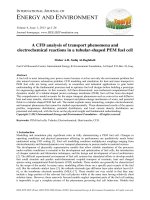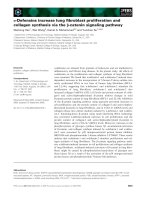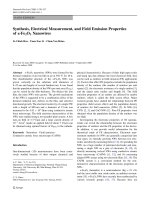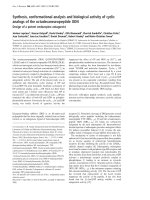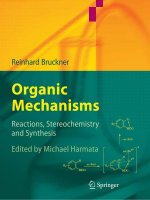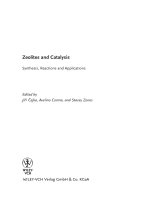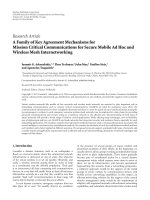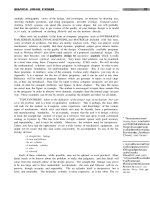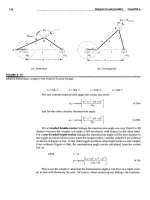Vakhid a mamedov quinoxalines synthesis, reactions, mechanisms and structure springer (2016)
Bạn đang xem bản rút gọn của tài liệu. Xem và tải ngay bản đầy đủ của tài liệu tại đây (35.33 MB, 455 trang )
Vakhid A. Mamedov
Quinoxalines
Synthesis, Reactions, Mechanisms and
Structure
Quinoxalines
www.pdfgrip.com
www.pdfgrip.com
Vakhid A. Mamedov
Quinoxalines
Synthesis, Reactions, Mechanisms
and Structure
123
www.pdfgrip.com
Vakhid A. Mamedov
A.E. Arbuzov Institute of Organic and
Physical Chemistry
Kazan Scientific Center, Russian Academy
of Sciences
Kazan
Russia
ISBN 978-3-319-29771-2
DOI 10.1007/978-3-319-29773-6
ISBN 978-3-319-29773-6
(eBook)
Library of Congress Control Number: 2016931837
© Springer International Publishing Switzerland 2016
This work is subject to copyright. All rights are reserved by the Publisher, whether the whole or part
of the material is concerned, specifically the rights of translation, reprinting, reuse of illustrations,
recitation, broadcasting, reproduction on microfilms or in any other physical way, and transmission
or information storage and retrieval, electronic adaptation, computer software, or by similar or dissimilar
methodology now known or hereafter developed.
The use of general descriptive names, registered names, trademarks, service marks, etc. in this
publication does not imply, even in the absence of a specific statement, that such names are exempt from
the relevant protective laws and regulations and therefore free for general use.
The publisher, the authors and the editors are safe to assume that the advice and information in this
book are believed to be true and accurate at the date of publication. Neither the publisher nor the
authors or the editors give a warranty, express or implied, with respect to the material contained herein or
for any errors or omissions that may have been made.
Printed on acid-free paper
This Springer imprint is published by SpringerNature
The registered company is Springer International Publishing AG Switzerland
www.pdfgrip.com
Foreword
Heterocycles form a fundamental basis for the development of pharmaceutical and
agricultural products with wide applications. In this book the author describes the
synthesis, and the chemical properties of an important class of heterocyclic
chemistry, the quinoxalines.
Chapter 1 describes some properties of the Quinoxaline–As a Parent Heterocycle.
Chapter 2 covers recent advances in the Synthesis of Quinoxalines involving the
methods based on the (a) condensation of 1,2-diaminobenzenes and derivatives
with various two-carbon unit suppliers, (b) condensation of o-benzoquinone
diimines and diimides with various two-carbon unit suppliers, (c) condensation of
N,N-dimethyl(dibenzyl)ethylenediamine with 1,2- and 1,4-dihydroxybenzenes,
(d) synthesis of quinoxalines from aniline and its derivatives, (e) synthesis of
quinoxalines from heterocyclic systems and (f) synthesis of quinoxalines based on
the carbocyclic system.
From the data presented in this chapter many original and interesting methods
recently appeared for the synthesis of quinoxalines, which are difficult to obtain or
in general are unobtainable. These new methods by Kaufmann, Tanimori, Kalinski
and Shaabani are based on the reactions of a wide variety of compounds that
deserve further attention.
Chapter 3 describes two methods of the Synthesis of Pyrrolo[l,2-a]quinoxalines
based both on quinoxalines and pyrroles. Chapter 4 captures the Synthesis of
Imidazo[1,5-a]- and Imidazo[1,2-a]quinoxalines. Chapter 5 discusses the Synthesis
of Quinoxaline Macrocycles through (a) introduction of the quinoxaline system into
macrocycles, (b) the closing of 1,n-bis(quinoxalin-1-yl)alkanes and (c) from both
resorcin[4]arenes and quinoxalines. Chapter 6 demonstrates all known
Rearrangements of Quinoxalin(on)es in the Synthesis of Benzimidazol(on)es and the
interesting new rearrangements discovered by Mamedov, the author of this book,
comprising (a) the acid catalysed conversion of “any of the spiro-derivatives of
1,2,3,4-tetrahydrtinquinoxalin-3-one with at least one mobile hydrogen atom in their
spiro-forming component into benzimidazole derivative with the spiro-forming
v
www.pdfgrip.com
vi
Foreword
component at position 2” and (b) the acid catalyzed rearrangement of “any of the
spiro-derivatives of 1,2,3,4-tetrahydroquinoxalin-3-one without any mobile hydrogen atom in their spiro-forming component are on their way to the benzimidazolone
derivative with the spiro-forming component at position 1”.
Henk van der Plas
www.pdfgrip.com
Preface
The book gives equal weight to each of the fundamental aspects of quinoxaline
chemistry: synthesis, reactions, mechanisms, structure, properties, and uses. The
first four chapters present a survey of the developments in quinoxaline chemistry
since the publication of the monograph on “Condensed Pyrazines” by Cheeseman
and Cookson in 1979. These chapters give a comprehensive coverage of the
important quinoxaline-containing ring systems such as thiazolo[3,4-a]-, pyrrolo
[1,2-a]-, imidazo[1,5-a]-, pyrano[2,3-b]quinoxalines, etc. Chapter five describes
many new methods for the construction of quinoxaline macrocycles, which are
important because of their application to optical devices and materials. The
remaining sixth chapter gives a review of all the previously known rearrangements
of heterocyclic systems that lead to benzimidazole derivatives. A critical analysis
of these transformations reveals novel acid-catalyzed rearrangements of quinoxalinones giving 2-heteroaryl benzimidazoles and 1-heteroaryl benzimidazolones in
the presence of nucleophilic reactants. The Appendix gives X-ray crystallographic
data for a number of quinoxaline derivatives (41 samples) synthesized in the
Laboratory of the Chemistry of Heterocyclic Compounds of the A.E. Arbuzov
Institute of Organic and Physical Chemistry, Kazan Scientific Centre of the Russian
Academy of Sciences. The literature has been covered up to the end of 2013, with
some additional data from publications in 2014 and 2015.
This book is the result of a collective effort. I find it necessary to acknowledge
the assistance rendered by the compilers of this book Dr. Nataliya A. Zhukova, who
contributed to the final version of the manuscript and also Dr. Elena A. Hafizova,
Dr. Liliya V. Mustakimova and the authors of the dissertations Dr. A.A. Kalinin (in
Chap. 6), Dr. D.F. Saifina (in Chap. 6), Ph.D. O.G. Isaykina (in Chap. 6), Ph.D. A.
M. Murtazina (in Chap. 6) and Ph.D. V.R. Galimullina (in Chap. 6) as well as all
my co-workers whose names appear in the references. My profound thanks are due
to Ida H. Rapoport for her invaluable assistance in reading the first English version
of the manuscript. Special acknowledgments are due to Prof. Aidar T. Gubaidullin
for X-ray structural analyses of all the compounds and the X-ray structural analyses
data in the Appendix. I take this opportunity to express my special thanks to the
vii
www.pdfgrip.com
viii
Preface
administration and mainly to the director of the A.E. Arbuzov Institute of Organic
and Physical Chemistry of the Kazan Research Center of the Russian Academy of
Sciences Prof. Oleg G. Sinyashin for his interest in our research and to the Russian
Foundation for Basic Research for funding (Grants No. 07-03-00613-a,
10-03-00413-a, 13-03-00123-a). The completion of this endeavor would have never
been possible without the consent of Prof. Bert U.W. Maes from the University of
Antwerp, whom I am extremely grateful to. And last, but no means least, I consider
myself indebted to Profs. Yakov A. Levin and Ildus A. Nuretdinov of the A.E.
Arbuzov Institute, Eugene A. Berdnikov of the Kazan University and Sadao Tsuboi
of the Okayama University (Japan). Their dedication and skill taught me how to
teach. I thank them.
Finally, I should like to thank Prof. John A. Joule from the University of
Manchester, who has constantly provided me with helpful advice and criticism as
regards the grammatical and editing aspects while the manuscript was in preparation. I am particularly grateful to my wife Dr. Vera L. Mamedova and my son Javid
and daughter Sevil. They endured with patience and understanding the many days
and nights of my staying at the Institute and the endless hours on the computer.
They helped me in so many ways that are too numerous to mention.
www.pdfgrip.com
Contents
1 Quinoxaline–As a Parent Heterocycle . . . . . . . . . . . . . . . . . . . . . .
References . . . . . . . . . . . . . . . . . . . . . . . . . . . . . . . . . . . . . . . . . .
1
3
2 Synthesis of Quinoxalines . . . . . . . . . . . . . . . . . . . . . . . . . .
2.1 Introduction. . . . . . . . . . . . . . . . . . . . . . . . . . . . . . . .
2.2 Condensation of 1,2-Diaminobenzenes (1,2-DABs;
Ortho-Phenylenediamines) and Derivatives with Various
Two-Carbon Unit Suppliers. . . . . . . . . . . . . . . . . . . . .
2.2.1 With Pyruvates (2-Oxopropanoates) . . . . . . . . .
2.2.2 With α-Diketones (1,2-Diketones) . . . . . . . . . .
2.2.3 With Ketones . . . . . . . . . . . . . . . . . . . . . . . .
2.2.4 With Hexane-1,3,4,6-tetraones . . . . . . . . . . . . .
2.2.5 With Haloketones. . . . . . . . . . . . . . . . . . . . . .
2.2.6 With α-Hydroxy Ketones . . . . . . . . . . . . . . . .
2.2.7 With Vicinal Diols . . . . . . . . . . . . . . . . . . . . .
2.2.8 With Dimethyl (DMAD) and Diethyl (DEAD)
Acetylenedicarboxylates . . . . . . . . . . . . . . . . .
2.2.9 With Nitroolefins . . . . . . . . . . . . . . . . . . . . . .
2.2.10 With 1,2-Diaza-1,3-butadienes . . . . . . . . . . . . .
2.2.11 With Ketones(Aldehydes) and Isocyanide . . . . .
2.2.12 With Aldehydes and NaCN . . . . . . . . . . . . . . .
2.3 Condensation of o-Benzoquinone Diimines and Diimides
with Various Two-Carbon Unit Suppliers . . . . . . . . . . .
2.3.1 With Allylstannane. . . . . . . . . . . . . . . . . . . . .
2.3.2 With Aldehydes . . . . . . . . . . . . . . . . . . . . . . .
2.3.3 With 1,2-DAB . . . . . . . . . . . . . . . . . . . . . . . .
2.4 Condensation of N,N-Dimethyl(dibenzyl)ethylenediamine
with 1,2- and 1,4-Dihydroxy Benzenes . . . . . . . . . . . . .
5
5
.....
.....
.
.
.
.
.
.
.
.
.
.
.
.
.
.
.
.
.
.
.
.
.
.
.
.
.
.
.
.
.
.
.
.
.
.
.
.
.
.
.
.
14
14
22
29
32
32
37
37
.
.
.
.
.
.
.
.
.
.
.
.
.
.
.
.
.
.
.
.
.
.
.
.
.
37
40
42
43
46
.
.
.
.
.
.
.
.
.
.
.
.
.
.
.
.
.
.
.
.
48
48
50
51
.....
52
ix
www.pdfgrip.com
x
Contents
2.5
Synthesis of Quinoxalines from Aniline and Its Derivatives. .
2.5.1 From Anilines . . . . . . . . . . . . . . . . . . . . . . . . . . .
2.5.2 From Benzil-α-arylimino Oximes
and α-Nitroketene N,S-Anilinoacetals . . . . . . . . . . .
2.5.3 From 2-Haloanilines . . . . . . . . . . . . . . . . . . . . . . .
2.5.4 From Nitroanilines . . . . . . . . . . . . . . . . . . . . . . . .
2.5.5 From 2-Fluoro-1-nitrobenzenes . . . . . . . . . . . . . . .
2.5.6 From 4-Bromo-5-nitrophthalonitrile . . . . . . . . . . . .
2.5.7 From N-Aryl-2-nitrosoanilines and Alkylated
Cyanoacetic Esters . . . . . . . . . . . . . . . . . . . . . . . .
2.6 Synthesis of Quinoxalines from Heterocyclic Systems . . . . .
2.6.1 Synthesis of Quinoxalines from Various Fused
Nitrogen-Containing Heterocycles Without
a Pyrazine Fragment. . . . . . . . . . . . . . . . . . . . . . .
2.6.2 Synthesis of Quinoxalines from Various
Heterocyclic Systems, Containing Neither
a Pyrazine ring nor a Benzofragment . . . . . . . . . . .
2.6.3 Synthesis of Quinoxalines from Heterocyclic
Systems with a Pyrazine Ring . . . . . . . . . . . . . . . .
2.7 Synthesis of Quinoxalines Based on the Carbocyclic System .
2.7.1 From 3,3,6,6-Tetrachloro-1,2-cyclohexanedione . . . .
2.7.2 From Ninhydrin . . . . . . . . . . . . . . . . . . . . . . . . . .
2.7.3 From 1,2-Difluorobenzene . . . . . . . . . . . . . . . . . . .
2.8 Conclusion . . . . . . . . . . . . . . . . . . . . . . . . . . . . . . . . . . .
References . . . . . . . . . . . . . . . . . . . . . . . . . . . . . . . . . . . . . . . .
3 Synthesis of Pyrrolo[l,2-a]quinoxalines . . . . . . . . . . . . . . . . . . .
3.1 Pyrrolo[1,2-a]quinoxalines Based on Quinoxalines . . . . . . . .
3.1.1 Introduction. . . . . . . . . . . . . . . . . . . . . . . . . . . . .
3.1.2 Possible Variants of the Construction of the Pyrrolo
[1,2-a]quinoxaline System on the Basis
of Quinoxalines . . . . . . . . . . . . . . . . . . . . . . . . . .
3.1.3 Production Methods of Type QA (Version QA1) . . .
3.1.4 Production Methods of Type QB (Version QB1) . . .
3.1.5 Production Methods of Type QB (Version QB3) . . .
3.1.6 Production Methods of Type QC (Version QC1)
Cycloaddition Reactions . . . . . . . . . . . . . . . . . . . .
3.1.7 Production Methods of Type QC (Version QC2) . . .
3.1.8 Production Methods of Type QD . . . . . . . . . . . . . .
3.1.9 Production Methods of Type QE1 . . . . . . . . . . . . .
3.1.10 Production Methods of Type QE2 . . . . . . . . . . . . .
3.1.11 Other Methods of Synthesis. . . . . . . . . . . . . . . . . .
3.1.12 Conclusion . . . . . . . . . . . . . . . . . . . . . . . . . . . . .
www.pdfgrip.com
..
..
57
57
.
.
.
.
.
.
.
.
.
.
58
60
66
68
71
..
..
71
73
..
74
..
84
.
.
.
.
.
.
.
.
.
.
.
.
.
.
102
102
102
103
104
104
105
..
..
..
135
135
135
.
.
.
.
.
.
.
.
135
137
141
142
.
.
.
.
.
.
.
.
.
.
.
.
.
.
142
146
150
151
151
152
158
Contents
xi
3.2
Pyrrolo[l,2-a]quinoxalines Based on Pyrroles.
3.2.1 Introduction. . . . . . . . . . . . . . . . . .
3.2.2 Type PA1 Production Methods . . . .
3.2.3 Type PA2 Production Methods . . . .
3.2.4 Type PA3 Production Methods . . . .
3.2.5 Type PA4 Production Methods . . . .
3.2.6 Type PB1 Production Methods . . . .
3.2.7 Type PB2 Production Methods . . . .
3.2.8 Type PD Production Methods . . . . .
3.2.9 Other Methods of Synthesis. . . . . . .
3.2.10 Conclusion . . . . . . . . . . . . . . . . . .
References . . . . . . . . . . . . . . . . . . . . . . . . . . . . .
.
.
.
.
.
.
.
.
.
.
.
.
.
.
.
.
.
.
.
.
.
.
.
.
.
.
.
.
.
.
.
.
.
.
.
.
.
.
.
.
.
.
.
.
.
.
.
.
.
.
.
.
.
.
.
.
.
.
.
.
.
.
.
.
.
.
.
.
.
.
.
.
.
.
.
.
.
.
.
.
.
.
.
.
.
.
.
.
.
.
.
.
.
.
.
.
.
.
.
.
.
.
.
.
.
.
.
.
.
.
.
.
.
.
.
.
.
.
.
.
4 Synthesis of Imidazo[1,5-a]- and Imidazo[1,2-a]quinoxalines . .
4.1 Introduction. . . . . . . . . . . . . . . . . . . . . . . . . . . . . . . . . .
4.2 Synthesis of Imidazo[1,5-a]quinoxalines on the Basis
of Quinoxaline Derivatives . . . . . . . . . . . . . . . . . . . . . . .
4.2.1 Methods of Formation of the N(10)–C(1) Bond
(Variant A1Q) . . . . . . . . . . . . . . . . . . . . . . . . . .
4.2.2 Method of Formation of the C(1)–N(2) Bond
(Variant A2Q) . . . . . . . . . . . . . . . . . . . . . . . . . .
4.2.3 Method of Formation of the N(2)–C(3) Bond
(Variant A3Q) . . . . . . . . . . . . . . . . . . . . . . . . . .
4.2.4 Methods of Formation of the N(10)–C(1)
and C(1)–N(2) Bonds (Variant B1Q). . . . . . . . . . .
4.2.5 Methods of Formation of the N(10)–C(1)
and N(2)–C(3) Bonds (Variant C1Q). . . . . . . . . . .
4.2.6 Methods of Formation of the N(10)–C(1)
and C(3)–C(3a) Bonds (Variant DQ) . . . . . . . . . . .
4.2.7 Method of Formation of the N(10)–C(1),
C(1)–N(2), and N(2)–C(3) Bonds (Variant E1Q). . .
4.3 Synthesis of Imidazo[1,5-a]quinoxalines
Based on Imidazole Derivatives . . . . . . . . . . . . . . . . . . . .
4.3.1 Method of Formation of the C(3a)–C(4) Bond
(Variant A1I) . . . . . . . . . . . . . . . . . . . . . . . . . . .
4.3.2 Methods of Formation of the C(4)–N(5) Bond
(Variant A2I) . . . . . . . . . . . . . . . . . . . . . . . . . . .
4.3.3 Methods of Formation of the C(9a)–N(10) Bond
(Variant A4I) . . . . . . . . . . . . . . . . . . . . . . . . . . .
4.3.4 Methods of Formation of the C(3a)–C(4)
and C(4)–N(5) Bonds (Variant B1I) . . . . . . . . . . .
4.4 Other Methods of Synthesis of Imidazo[1,5-a]Quinoxalines.
4.5 Synthesis of Imidazo[1,2-a]quinoxalines Based
on Quinoxaline Derivatives . . . . . . . . . . . . . . . . . . . . . . .
www.pdfgrip.com
.
.
.
.
.
.
.
.
.
.
.
.
.
.
.
.
.
.
.
.
.
.
.
.
.
.
.
.
.
.
.
.
.
.
.
.
159
159
159
163
165
166
166
187
188
190
200
200
...
...
211
211
...
212
...
213
...
217
...
218
...
218
...
220
...
223
...
228
...
229
...
229
...
230
...
232
...
...
233
237
...
239
xii
Contents
4.5.1
Methods of Formation of the N(10)–C(1) Bond
(Variant A1Q) . . . . . . . . . . . . . . . . . . . . . . . . . .
4.5.2 Method of Formation of the C(2)–N(3) Bond
(Variant A3Q) . . . . . . . . . . . . . . . . . . . . . . . . . .
4.5.3 Method of Formation of the C(2)–N(3)
and N(3)–C(3a) Bonds (Variant B3Q) . . . . . . . . . .
4.5.4 Methods of Formation the N(10)–C(1)
and C(2)–N(3) Bonds (Variant C1Q). . . . . . . . . . .
4.5.5 Method of Formation of the N(10)–C(1)
and N(3)–C(3a) Bond (Variant DQ) . . . . . . . . . . .
4.5.6 Method of Formation of the N(10)–C(1),
C(1)–C(2) and C(2)–N(3) Bonds (Variant E1Q) . . .
4.6 Synthesis of Imidazo[1,2-a]quinoxalines on the Basis
of Imidazole Derivatives . . . . . . . . . . . . . . . . . . . . . . . . .
4.6.1 Method of Formation of the C(3a)–C(4) Bond
(Variant A1I) . . . . . . . . . . . . . . . . . . . . . . . . . . .
4.6.2 Methods of Formation of the C(4)–N(5) Bond
(Variant A2I) . . . . . . . . . . . . . . . . . . . . . . . . . . .
4.6.3 Methods of Formation of the C(9a)–N(10) Bond
(Variant A4I) . . . . . . . . . . . . . . . . . . . . . . . . . . .
4.6.4 Methods of Formation of the C(3a)–C(4)
and C(4)–N(5) Bonds (Variant B1I) . . . . . . . . . . .
4.6.5 Methods of Formation of the C(4)–N(5)
and C(9a)–N(10) Bonds (Variant D1I) . . . . . . . . .
4.7 Other Methods of Synthesis of Imidazo[1,2-a]quinoxalines .
4.8 Biological Activity of Imidazo[1,5-a]- and Imidazo[1,2-a]
quinoxalines . . . . . . . . . . . . . . . . . . . . . . . . . . . . . . . . .
4.8.1 Kinase Inhibition . . . . . . . . . . . . . . . . . . . . . . . .
4.8.2 Phosphodiesterase Inhibition . . . . . . . . . . . . . . . .
4.8.3 Antimicrobial and Antifungal Activity . . . . . . . . .
4.9 Conclusions . . . . . . . . . . . . . . . . . . . . . . . . . . . . . . . . .
References . . . . . . . . . . . . . . . . . . . . . . . . . . . . . . . . . . . . . . .
5 Synthesis of Quinoxaline Macrocycles . . . . . . . . . . . . .
5.1 Introduction. . . . . . . . . . . . . . . . . . . . . . . . . . . .
5.2 The Introduction of the Quinoxaline System into
Macrocycles . . . . . . . . . . . . . . . . . . . . . . . . . . .
5.2.1 N,N′-Polymethylene-1,2-Diaminobenzenes .
5.2.2 Crown Ethers with Diaminobenzene and
Benzofuroxane Moieties . . . . . . . . . . . . .
5.2.3 Macrocyclic Diketones . . . . . . . . . . . . . .
5.2.4 Porphyrins. . . . . . . . . . . . . . . . . . . . . . .
5.2.5 Resorcin[4]arene Cavitands . . . . . . . . . . .
www.pdfgrip.com
...
239
...
244
...
244
...
244
...
245
...
246
...
247
...
248
...
248
...
250
...
251
...
...
252
254
.
.
.
.
.
.
.
.
.
.
.
.
255
255
257
258
258
261
.........
.........
271
271
.........
.........
272
273
.
.
.
.
273
275
276
285
.
.
.
.
.
.
.
.
.
.
.
.
.
.
.
.
.
.
.
.
.
.
.
.
.
.
.
.
.
.
.
.
.
.
.
.
.
.
Contents
xiii
5.3
Quinoxaline Derivatives in the Synthesis of Macrocycles .
5.3.1 Quinoxalin-2,3(1H,4H)-dione,
2,3-Dichloroquinoxaline and Quinoxalin-2,3
(1H,4H)-dithione . . . . . . . . . . . . . . . . . . . . . . .
5.3.2 2,3-Dibromomethylquinoxaline . . . . . . . . . . . . .
5.3.3 Diphenylquinoxalines . . . . . . . . . . . . . . . . . . . .
5.3.4 2,3-Di(pyrrol-2-yl)quinoxalines . . . . . . . . . . . . .
5.3.5 2,3- and 6,7-Dicyanoquinoxalines. . . . . . . . . . . .
5.4 1,n-Bis(quinoxalin-1-yl)alkanes in the Synthesis
of Macrocycles . . . . . . . . . . . . . . . . . . . . . . . . . . . . . .
5.4.1 1,n-Bis(3-acetylquinoxalin-2-on-1-yl)alkanes . . . .
5.4.2 1,n-Bis(3-benzoylquinoxalin-2-on-1-yl)alkanes . . .
5.4.3 Bis(3-indolizinylquinoxalin-2-on-1-yl)alkanes . . .
5.5 Both Resorcin[4]arenes and Quinoxalines in the Synthesis
of Macrocycles . . . . . . . . . . . . . . . . . . . . . . . . . . . . . .
5.6 Other Methods of Synthesis . . . . . . . . . . . . . . . . . . . . .
5.6.1 Pyran 1,4-Diazaphenanthrenes . . . . . . . . . . . . . .
5.6.2 Quinoxaline-2,3-dicarboximide. . . . . . . . . . . . . .
5.6.3 Macrocyclic Quinoxaline Compounds
as Anticancer Drugs and Inhibitors of Hepatitis
C Virus. . . . . . . . . . . . . . . . . . . . . . . . . . . . . .
5.7 Conclusion . . . . . . . . . . . . . . . . . . . . . . . . . . . . . . . . .
References . . . . . . . . . . . . . . . . . . . . . . . . . . . . . . . . . . . . . .
....
287
.
.
.
.
.
.
.
.
.
.
.
.
.
.
.
.
.
.
.
.
288
291
295
297
302
.
.
.
.
.
.
.
.
.
.
.
.
.
.
.
.
308
308
310
314
.
.
.
.
.
.
.
.
.
.
.
.
.
.
.
.
317
323
323
324
....
....
....
325
330
331
6 Rearrangements of Quinoxalin(on)es for the Synthesis
of Benzimidazol(on)es. . . . . . . . . . . . . . . . . . . . . . . . . . . . . . . . .
6.1 Introduction. . . . . . . . . . . . . . . . . . . . . . . . . . . . . . . . . . . .
6.2 Synthesis of Benzimidazoles . . . . . . . . . . . . . . . . . . . . . . . .
6.2.1 Rearrangement of Quinoxalines (Historical
Background) . . . . . . . . . . . . . . . . . . . . . . . . . . . . .
6.2.2 Principles of the Method . . . . . . . . . . . . . . . . . . . . .
6.2.3 Advantages of the Method . . . . . . . . . . . . . . . . . . .
6.3 Synthesis of 2-(Benzimidazol-2-yl)quinoxalines
with no Use Rearrangements . . . . . . . . . . . . . . . . . . . . . . . .
6.3.1 Gold Catalysis for Synthesizing 2-(Benzimidazol-2-yl)
quinoxaline Derivatives from Glycerol
and 1,2-Diaminobenzenes . . . . . . . . . . . . . . . . . . . .
6.3.2 Synthesis of Quinoxalines
and 2-(Benzimidazol-2-yl)quinoxalines via
the Isocyanide Based Multicomponent Reactions
(IMCRs) . . . . . . . . . . . . . . . . . . . . . . . . . . . . . . . .
6.4 Synthesis of 2-Hetarylquinoxalines via Rearrangements
(Use of 3-Aroyl-, 3-Alkanoyl- and 3-Hetaroylquinoxalin2(1H)-ones as Analogues of α-Diketones) . . . . . . . . . . . . . . .
www.pdfgrip.com
.
.
.
343
343
346
.
.
.
346
351
352
.
356
.
356
.
360
.
363
xiv
Contents
6.4.1
Synthesis of 2-(Benzimidazol-2-yl)quinoxalines
and Their Aza-Analogues . . . . . . . . . . . . . . . . . . .
6.4.2 Synthesis of 2,3-Bis(benzimidazol-2-yl)
quinoxalines . . . . . . . . . . . . . . . . . . . . . . . . . . . .
6.4.3 Synthesis of 2-(Pyrazin-2-yl)benzimidazoles . . . . . .
6.4.4 Synthesis of 2-(Imidazol-4-yl)benzimidazoles. . . . . .
6.5 Synthesis of 2-(3-Arylindolizin-2-yl)benzimidazole
via the Rearrangement (Use of 3-α-Chlorobenzyland α-Chloroalkylquinoxalin-2(1H)-ones as Analogues
of α-Haloketones) . . . . . . . . . . . . . . . . . . . . . . . . . . . . . .
6.6 Synthesis of 2-(Pyrazol-3-yl)benzimidazoles via the
Rearrangement (Use of 3-Arylacylidene-3,4Dihydroquinoxalin-2(1H)-ones as Analogues
of β-Diketones) . . . . . . . . . . . . . . . . . . . . . . . . . . . . . . . .
6.7 Synthesis of 2-(Pyrrol-3-yl)benzimidazole via the
Rearrangement (Use of 3-α-Aminobenzylquinoxalin2(1H)-ones as Analogues of α-Aminoketones) . . . . . . . . . . .
6.8 Synthesis of 2-(Benzimidazol-2-yl)quinolines
via the Rearrangement (Use of 3-Methylquinoxalin2(1H)-ones as Analogues of Usual Ketones) . . . . . . . . . . . .
6.9 Synthesis of 4-(Benzimidazol-2-yl)quinolines via the
Rearrangement (Use of 3-(2-Aminophenyl)quinoxalin2(1H)-ones as Aromatic o-Aminoaldehydes (or Ketones) . . .
6.9.1 Synthesis of Structurally Diverse Quinoline
Derivatives with Benzimidazole Moieties . . . . . . . .
6.9.2 Synthesis of Benzimidazolo[2,1-a]pyrrolo[3,4-c]
quinolines . . . . . . . . . . . . . . . . . . . . . . . . . . . . . .
6.9.3 Synthesis of 1-(1H-Indazol-3-yl)-1H-benzimidazol-2
(3H)-one . . . . . . . . . . . . . . . . . . . . . . . . . . . . . . .
6.10 Synthesis of 1-Pyrrolylbenzimidazolones via the New
Rearrangements (Use of 3-Aroyl-, 3-Alkanoyland 3-Hetaroylquinoxalin-2(1H)-ones as Analogues
of α-Diketones) . . . . . . . . . . . . . . . . . . . . . . . . . . . . . . . .
6.10.1 Synthesis of 2,3-Di(1H-benzimidazol-2-yl)-1(1H-benzoimidazol-2-on-1-yl)pyrrolo[1,2-a]
quinoxalin-4(5H)-one . . . . . . . . . . . . . . . . . . . . . .
6.10.2 Synthesis of 3-[(3,5-Disubstituted-4-(1Hbenzimidazol-2-on-1-yl)-1H-pyrrol-2-yl]quinoxalin2(1H)-ones . . . . . . . . . . . . . . . . . . . . . . . . . . . . .
6.10.3 Synthesis of 1-Pyrrolylbenzimidazolones
from Quinoxalinones and Enamines Generated
In Situ from Ketones and Ammonium Acetate . . . . .
www.pdfgrip.com
..
363
..
..
..
367
374
378
..
382
..
384
..
387
..
389
..
391
..
391
..
395
..
396
..
397
..
397
..
399
..
400
Contents
xv
6.10.4 A Reaction for the Synthesis of Benzimidazol-2-ones,
Imidazo[5,4-b]- and Imidazo[4,5-c]pyridin-2-ones from
Quinoxalinones and Their Aza-Analogues
When Exposed to Enamines . . . . . . . . . . . . . . . . . . .
6.11 Conclusion . . . . . . . . . . . . . . . . . . . . . . . . . . . . . . . . . . . . .
References . . . . . . . . . . . . . . . . . . . . . . . . . . . . . . . . . . . . . . . . . .
405
409
410
Appendix . . . . . . . . . . . . . . . . . . . . . . . . . . . . . . . . . . . . . . . . . . . . .
423
www.pdfgrip.com
www.pdfgrip.com
Chapter 1
Quinoxaline–As a Parent Heterocycle
5
6
7
8
N
N
4
3
2
1
Quinoxaline
Quinoxalines are products of the spontaneous condensation of
1,2-diaminobenzene (1,2-DAB) with 1,2-dicarbonyl compounds (Scheme 1.1). The
reaction was independently discovered many years ago by Hinsberg (1884) and
Körner (1884).
Hinsberg suggested calling this series of compounds quinoxalines to point out
their relationship with quinolines and the glyoxal—the dicarbonyl compound, from
which the first representative of the series was obtained. Quinoxaline: [Quin
(oline) + (gly)oxal + ine] (Hinsberg 1884).
Quinoxaline is a bicyclic heterocycle consisting of a benzene ring fused to a
pyrazine, hence a quinoxaline is also called Benzo[a]pyrazine, Benzopyrazine,
Benzoparadiazine, 1,4-Benzodiazine, Phenopiazine, Phenpiazine, Quinazine, and
Chinoxalin. It is isomeric with quinazoline, phthalazine, and cinnoline.
N
N
quinazoline
N
N
phthalazine
N
N
cinnoline
At least five methods are currently used for the synthesis of quinoxaline 3
(R = H). The first and the principal method is based on the condensation of
1,2-DAB with two-carbon suppliers, such as glyoxal (Mirjalili and Akbari 2011;
Rahmatpour 2012; Chandra Shekhar et al. 2014) (Scheme 1.2, Eq. 1),
ethane-1,2-diol (Climent et al. 2012; Tang et al. 2015) (Scheme 1.2, Eq. 2),
2-aminoethanol (Tang et al. 2015) (Scheme 1.2, Eq. 3), 1,4-dioxane-2,3-diol
(Venuti 1982) (Scheme 1.2, Eq. 4). The second method is based on the reaction of
© Springer International Publishing Switzerland 2016
V.A. Mamedov, Quinoxalines, DOI 10.1007/978-3-319-29773-6_1
www.pdfgrip.com
1
2
1 Quinoxaline–As a Parent Heterocycle
O
NH2
R
N
R
N
R
+
NH2
1
O
R
- 2H2O
3
2
Scheme 1.1 Hinsberg and Körner synthesis of quinoxalines
2-nitroaniline with ethane-1,2-diol (Nguyen et al. 2015) (Scheme 1.2, Eq. 5). The
third is the self-condensation of aniline derivatives, such as N-ethyl-2-nitroaniline
(Walczak et al. 2015) (Scheme 1.2, Eq. 6) and N-[2-(2-phenylhydrazono)ethylidene]aniline (McNab 1980; Duffy et al. 2004) (Scheme 1.2, Eq. 7). The fourth
method is based on the condensation of benzofurazan (benzo[c][1,2,5]oxadiazole)
with 2-aminoethanol (Samsonov 2007) (Scheme 1.2, Eq. 8), and the fifth method is
based on the redox processes of various quinoxaline derivatives (Hirasawa et al.
2008; Karki et al. 2013; Chelucci and Figus 2014; Cui et al. 2015; Jeong et al.
2015) (Scheme 1.3).
Quinoxaline 3 (R = H) is a light yellow to brown crystalline, water-soluble
powder, with the molecular formula C8H6N2 and the molar mass 130.15 g/mol. The
O
O
i or ii or iii
(1)
O2N
H2N
O2N
iv
(2)
NH2
vii
(5)
OH
HO
OH
HO
viii
(6)
N
NH2
N
H
N
NH2
HO
v
(3)
OH
O
O
Ph
ix or x
(7)
NH2
HO
xi
(8)
OH
vi
(4)
i = aq. HF, rt (98%)
ii = PS/AlCl3 (10 mol%), EtOH, reflux (95%)
iii = nano-TiO2, rt (88%)
iv = Au/CeO2 (cat), diglime (91%)
v = CsOH.H2O, MS, 120 oC, 23 h, O2 atmosphere (81%)
vi = EtOH, rt, 30 min (95%)
vii = FeCl3.6H2O, Na2S.nH2O, 180 oC, 24 h (67%)
viii = DMAC, toluene, K2CO3, 165 oC (5%)
ix = 600 oC, 0.01 Torr (35%)
x = 475 oC, 0.007 mbar, 35 min (78%)
xi = p-TsOH, 150-170 oC, 4 h (87%)
PS/AlCl3 = Polystyrene-supported aluminium chloride
DMAC = N,N-Dimethylacetamide
Scheme 1.2 Current methods for the quinoxaline ring synthesis
www.pdfgrip.com
N
O
N
N
N
H
N
Ph
1 Quinoxaline–As a Parent Heterocycle
Scheme 1.3 The use of
quinoxaline derivatives in
quinoxaline synthesis
3
N
N
N
I
i
ii
Cl
N
N
N
H
N
iv
N
H
O
iii
N+
N
i = In, water, reflux, 5.5 h (44%)
ii = Pd(OAc)2, PPh3, NaBH4, TMEDA, THF (72%)
iii = Cu(OTf)2, 1,2-DCE, MS 4Å, 60 oC, 12 h (81%)
iv = FeOx@NGr-C (cat), heptane, 15 bar air, 100 oC, 12 h (93%)
TMEDA = N,N,N',N'-Tetramethylethylenediamine;
1,2-DCE = 1,2-Dichloroethane;
FeOx@NGr-C=Iron oxides surrounded by nitrogen-doped-graphene sh
immobilized on carbon support
pKa (Albert 1963) of quinoxaline in water at 20 °C is 0.60: it is therefore considerably a weaker base than the isomer diazanaphthalenes namely, cinnoline
(pKa 2.42), phtalazine (pKa 3.47), and quinazoline (pKa 1.95). Quinoxaline has the
following physical properties: mp 29–32 °C, bp 220–223 °C, density 1.124 g/mL at
25 °C and flash point 209 °F TCC (98.33 °C) and is used mainly in organic
synthesis.
The 1H NMR spectrum of quinoxaline 3 (R = H) has been measured in DMSOd6. The signal for H(2) and H(3) of quinoxaline appears as an AA′BB′ system. The
low-field half of the AA′BB′ multiplet is assigned to the protons H(5) and H(8) and
the high-field half to the protons H(6) and H(7). Some broadening of the signals
from protons 5 and 7 is attributed to long-range coupling with protons 2 and 3. The
chemical shifts for protons 2 and 3, 5 and 8, and 6 and 7 are 8.97, 8.13–8.09, and
7.90–7.86 ppm (our result), respectively. As compared with the 8.85 (s, 2H),
8.17–8.05 (m, 2H), 7.84–7.72 (m, 2H) in CDCl3 (Cui et al. 2015) and 8.83 (s, 2H),
8.10 (dd, J = 4.2, 2.3 Hz, 2H), 7.76 (dd, J = 4.2, 2.3 Hz, 2H) in CDCl3 (Tang et al.
2015).
For a general introduction to quinoxaline chemistry as a parent heterocycle see
Chap. II in “Condensed Pyrazines” by Cheeseman and Cookson (1979).
References
Albert A (1963) In: Katritzky AR (ed) Physical methods in heterocyclic chemistry, vol 1, chap 1.
Academic Press, New York
Chandra Shekhar A, Ravi Kumar A, Sathaiah G, Raju K, Srinivas PVSS, Shanthan Rao P,
Narsaiah B (2014) Aqueous hydrofluoric acid catalyzed facile synthesis of 2,3,6-substituted
quinoxalines. J Heterocyclic Chem 51:1504–1508. doi:10.1002/jhet.1753
www.pdfgrip.com
4
1 Quinoxaline–As a Parent Heterocycle
Cheeseman GWH, Cookson RF (1979) Condensed pyrazines. In: Weissberger A, Taylor EC
(eds) The chemistry of heterocyclic compounds (a series of monographs). John Wiley and
Sons, New York, p 835
Chelucci G, Figus S (2014) NaBH4-TMEDA and a palladium catalyst as efficient regio- and
chemoselective system for the hydrodehalogenation of halogenated heterocycles. J Mol
Catal A Chem 393:191–209. doi:10.1016/j.molcata.2014.06.012
Climent MJ, Corma A, Hernández JC, Hungría AB, Iborra S, Martínez-Silvestre S (2012) Biomass
into chemicals: one-pot two- and three-step synthesis of quinoxalines from biomass-derived
glycols and 1,2-dinitrobenzene derivatives using supported gold nanoparticles as catalysts.
J Catal 292:118–129. doi:10.1016/j.jcat.2012.05.002
Cui X, Li Y, Bachmann S, Scalone M, Surkus A-E, Junge K, Topf C, Beller M (2015) Synthesis
and characterization of iron-nitrogen-doped graphene/core-shell catalysts: efficient oxidative
dehydrogenation of N-heterocycles. J Am Chem Soc 137:10652–10658. doi:10.1021/jacs.
5b05674
Duffy EF, Foot JS, McNab H, Milligan AA (2004) An empirical study of the effect of the variables
in a flash vacuum pyrolysis (FVP) experiment. Org Biomol Chem 2:2677–2683. doi:10.1039/
b410786c
Hinsberg O (1884) Ueber quinoxaline. Ber Dtsch Chem Ges 17(1):318–323. doi:10.1002/cber.
18840170193
Hirasawa N, Takahashi Y, Fukuda E, Sugimoto O, Tanji K-I (2008) Indium-mediated
dehalogenation of haloheteroaromatics in water. Tetrahedron Lett 49:1492–1494. doi:10.
1016/j.tetlet.2007.12.116
Jeong J, Lee D, Chang S (2015) Copper-catalyzed oxygen atom transfer of N-oxides leading to a
facile deoxygenation procedure applicable to both heterocyclic and amine N-oxides. Chem
Commun 51:7035–7038. doi:10.1039/c5cc01739d
Karki M, Araujo HC, Magolan J (2013) lDehydroaromatization with V2O5. Synlett 24(13):1675–
1678. doi:10.1055/s-0033-1339277 (Art ID:ST-2013-S0291-L)
Körner G (1884) Ueber einige umwandlungen des orthonitranilins und der orthodiamine. Ber
Dtsch Chem Ges 17(2):572–573
McNab H (1980) Mechanism of cyclisation of aryliminoiminyl radicals. JCS, Chem Comm 422–
423. doi:10.1039/C39800000422
Mirjalili BBF, Akbari A (2011) Nano-TiO2: an eco-friendly alternative for the synthesis of
quinoxalines. Chinese Chem Lett 22:753–756. doi:10.1016/j.cclet.2010.12.016
Nguyen TB, Ermolenko L, Al-Mourabit A (2015) Sodium sulfide: a sustainable solution for
unbalanced redox condensation reaction between o-nitroanilines and alcohols catalyzed by an
iron-sulfur system. Synthesis 47:1741–1748. doi:10.1055/s-0034-1380134 (Art ID:
ss-2014-c0749-st)
Rahmatpour A (2012) Polystyrene-supported AlCl3 as a highly active and reusable heterogeneous
Lewis acid catalyst for the one-pot synthesis of quinoxalines. Heteroatom Chem 23(5):472–
477. doi:10.1002/hc
Samsonov VA (2007) Furazan ring opening upon treatment of benzofurazan with ethanolamine to
yield quinoxalines. Russ Chem Bull, Int Ed 5(12):2510–2512
Tang W-H, Liu Y-H, Peng S-M, Liu S-T (2015) Ruthenium(II) η6-arene complexes containing a
dinucleating ligand based on 1,8-naphthyridine. J Organomet Chem 775:94–100. doi:10.1016/
j.jorganchem.2014.10.028
Venuti MC (1982) 2,3-Dihydroxy-1,4-dioxane: a stable synthetic equivalent of anhydrous glyoxal.
Synthesis 1:61–63. doi:10.1055/s-1982-29701
Walczak C, Payne TJ, Wade CB, Yonkey M, Scheid M, Badour A, Mohanty DK (2015) The
thermal instability of 2,4 and 2,6-N-alkylamino-disubstituted and 2-N-alkylamino-substituted
nitrobenzenes in weakly alkaline solution: sec-Amino effect. J Heterocyclic Chem 52:681–687.
doi:10.1002/jhet.2154
www.pdfgrip.com
Chapter 2
Synthesis of Quinoxalines
2.1
Introduction
The synthesis of quinoxalines has been intensively studied in the past, especially
because of the diverse biological activities ascribed to many representatives of this
class of compounds. Consequently, a large variety of synthetic methods for the
synthesis of functionalized quinoxalines has been reported in literature. The first
reports were published more than a century ago (Hinsberg 1884; Körner 1884), but
even today chemists endeavor to create new and improved routes to these versatile
compounds.
The synthesis and chemistry of quinoxalines have attracted considerable attention in the past 10 years (Porter 1984; Horton et al. 2003; Sherman et al. 2007;
Patidar et al. 2011). The quinoxaline moiety is present in a large variety of physiologically active compounds, with applications varying from medicinal to agricultural. Various quinoxalines exhibit biological activities including antiviral
(Westphal et al. 1977; Fonseca et al. 2004), in particular, against retroviruses such
as HIV (Loriga et al. 1997; Balzarini et al. 2000; Rosner et al. 1998; Patel et al.
2000), antibacterial (Griffith et al. 1992; El-Sabbagh et al. 2009), antimicrobial
(Sanna et al. 1999; Ali et al. 2000; Carta et al. 2001; Seitz et al. 2002; Badran et al.
2003; Singh et al. 2010), anti-inflammatory (Wagle et al. 2008; El-Sabbagh et al.
2009), antiprotozoal (Hui et al. 2006), anticancer (Monge et al. 1995a; Loriga et al.
1997; Lindsley et al. 2005; Carta et al. 2006), (colon cancer therapies) (LaBarbera
and Skibo 2005), antidepressant (Sarges et al. 1990), antifungal (Loriga et al. 1997;
El-Hawash et al. 1999; Carta et al. 2001), antituberculosis (Waring et al. 2002; Jaso
et al. 2003; Ancizu et al. 2010), antimalarial (Rangisetty et al. 2001; Guillon et al.
2004), antihelmintic (Sakata et al. 1988), antidiabetic (Gupta et al. 2005), and as
kinase inhibitors (Levitzki 2003; Lindsley et al. 2005). Additionally, they are used
in the agricultural field as fungicides, herbicides, and insecticides (Sakata et al.
1988). Quinoxaline moieties are also present in the structure of various antibiotics
such as echinomycin, levomycin, and actinoleutin, which are known to inhibit the
© Springer International Publishing Switzerland 2016
V.A. Mamedov, Quinoxalines, DOI 10.1007/978-3-319-29773-6_2
www.pdfgrip.com
5
6
2 Synthesis of Quinoxalines
growth of gram-positive bacteria and are active against various transplantable
tumors (Dell et al. 1975; Kim et al. 2004). In addition, quinoxaline derivatives have
found applications as dyes (Katoh et al. 2000; Sonawane and Rangnekar 2002;
Jaung 2006), efficient electroluminescent materials (Thomas et al. 2005), in organic
light-emitting devices (Fukuda et al. 1996; O’Brien et al. 1996; Wang et al. 2002;
Kulkarni et al. 2005; Thomas et al. 2005), as fluorescent materials (Ahmad et al.
1996; Hirayama et al. 2005; Tsami et al. 2007), organic semiconductors (O’Brien
et al. 1996; Dailey et al. 2001), chemically controllable switches (Crossley and
Johnston 2002), building blocks for the synthesis of anion receptors (Sessler et al.
2002), cavitands (Castro et al. 2004), dehydroannulenes (Sascha and Rudiger
2004), and DNA-cleaving agents (Yamaguchi et al. 1998; Kazunobu et al. 2002;
Hegedus et al. 2003; Patra et al. 2005). They also serve as useful rigid subunits in
macrocyclic receptors in molecular recognition (Elwahy 2000; Mizuno et al. 2002;
Kumar et al. 2008).
Besides these, quinoxalines have been identified as platforms for
diversity-oriented synthesis on a solid phase (Lee et al. 1997; Zaragoza and
Stephensen 1999), and they are established as inhibitors of aldose reductase (Sarges
and Lyga 1988), agonists of the γ-aminobutyric acid A (GABAA)/benzodiazepine
receptor complex (TenBrink et al. 1994; Jacobsen et al. 1996), antagonists of the
AMPA and angiotensin II receptors (Kim et al. 1993), antagonists of the selective
human A3 adenosine receptor (Catarzi et al. 2005), antagonists of 5-HT3 receptors
(Monge et al. 1993), growth inhibitors of Trypanosoma cruzi (Aguirre et al. 2004),
in the growth inhibition of Escherichia coli (Takeda et al. 2005), in cyclooxygenase
(COX-2) inhibitory activity (Singh et al. 2004), and as inhibitors of cholesteryl ester
transfer protein (Jones et al. 2005; Eary et al. 2007).
A number of selected examples of biologically active quinoxalines chosen from
an impressive list (Negwer and Scharnow 2001) are depicted in Fig. 2.1. Note: ‘R’
indicates the salt form of the drug; ‘S’ indicates the synonyms under which the drug
is known; ‘U’ indicates its medicinal use; and ‘P’ indicates the page in reference
(Negwer and Scharnow 2001).
As can be seen from the below data (Fig. 2.1) quinoxalines belong to a class of
excellent heterocyclic scaffolds owing to their wide biological properties and
diverse therapeutic applications in medicinal research. They are complementary in
shapes and charges to numerous biomolecules they interact with, thereby resulting
in increased binding affinity. The pharmacokinetic properties of drugs bearing
quinoxaline cores have shown them to be relatively easy to administer either as
intramuscular solutions, oral capsules, or rectal suppositories. Below (Figs. 2.2, 2.3,
2.4, 2.5, 2.6, 2.7, 2.8, 2.9, 2.10, 2.11, 2.12, 2.13, 2.14, 2.15, 2.16, 2.17 and 2.18) the
recent advances in the synthesis (see papers referred to under the structures) and
pharmacological diversities of quinoxaline motifs which might pave ways for novel
drugs development are given.
www.pdfgrip.com
2.1 Introduction
O
N
Cl
N
O
7
O
CN
N
N
H
MeO
N
MeO
N
S
F
N
N
H
R Monohydrochloride
S RPR 101511 A
U Tyrosine kinase
inhibitor
(P.914)
R Monohydrochloride
S Q-85 HCl
U Antihypoxic, cytotoxic
(P.952)
O
O
O
Cl
S GW 867
GW 420867
HBV-1293
Opaviralin
U Antiviral
(P.962)
N
NH
N
N
O
REV 3164,
RHC 3164,
Antiallergic,
Antiasthmatic
(P.663)
OMe
F3C
O
O
N
MeO
SMe
S
N
H
MeO
N
MeO
N
S HBT-097
HBY 097
Talviraline
U Antiviral (HIV-1)
(P.1130)
N
N
N
Cl
N
S AG-1296
U Protein tyrosine
kinase inhibitor
(P.1214)
N
N
H
N
CP 68247 Adenosin A1
receptor antagonist
(P.1060)
O
N
R also monohydrochloride,
S Calmaverin,
Calmaverine,
Caroverine, Delirex,
Espasmofibra, P201-1,
Spadon, Spasmium,
"Donau-Pharmazie",
Tinnitin, U Spasmolitic
(P.2293)
Cl
N
Cl
N
N
N
R Monohydrochloride
S CP-99711
U Glucagon receptor antagonist
(P.2248)
O
N
H
N
O
N
N
O
F3C
O
N
N
CO2H
S MM48, YM872
Zonampane
U Anticonvulsant,
neuroprotectant
(AMPA receptor antagonist)
(P.782) R also monohydrate
CO2H
OH
OH
N
O
S Dioxidine,
Dioxidin,
Dioxiplast
U Antibacterial
(P.435)
O2N
N
N
N
H
O
S LU 73068
U Anticonvulsant,
Glycin / NMDA and not
NMDA receptor antagonist
(P.777)
O
N
O
N
H
OH
N
O
S Bayo-Nox, Va9391
Celbar, Enterodox plus,
Fedan, Neo-Iccadox,
Olaquindox
U Antibacterial
growth stimulant
(veterinary) (P.687)
O
O
N
OH
O
N
O
S CP 22341, Temodox
U Antibacterial
growth stimulant
(veterinary)
(P.677)
Fig. 2.1 Quinoxaline containing drugs and their synonyms
www.pdfgrip.com
OH
N
O
S GS-7443-Mequidox
U Antibacterial
(P.434)
8
2 Synthesis of Quinoxalines
O
N
O
N
N
NHMe
O
O
O
N
O
O
Cl
S Chinoxidin,
Chinoxydin,
Quinoxidin
U Antibacterial
(P.935)
N
O
NO2
O
O2N
N
H
O
F3C
Cl
S CNQX, FG 9065
U Glutamate receptor
antagonist
(P.315)
N
N
N
H
N
CN
O
O
N
H
O
Cl
NO2
O
Cl
N
H
O
Cl
NO2
S ACEA 1011
U Glycine receptor
antagonist
(neuroprotective)
(P.315)
N
N
O
N
S FG 10571 NNC 14-0571
Panadiplon,
U 78875 anxiolytic
benzodiazepin receptor
partial agonist
(P.1545)
N
H
N
S 2720
U Antiviral
(P.942)
N
N
N
O
N
PO3H2
S Fanampanel
MPQX, ZK 200775
U Neuroprotectant
(AMPA receptor antagonist)
(P.944)
O
N
H
O
Cl
CO2H
N
O
S MCD-819
U Antibiotic from
Streptomyces ambofaciens
MA2870 (P.317)
R Sodium salt (22587-19-5)
H
N
O
O2N
H
N
O
N
H
O
O2N
N
H
O
S DNQX, FG 9065
U non-DMDA receptor
antagonist
(P.234)
CO2H
N
N
H
N
N
O
N
N
S Dazoquinast P.
Anti-allergic
(P.533)
Fig. 2.1 (continued)
www.pdfgrip.com
N
N
NEt2
CP 41475
Antidepressant
CNS stimulant
O
N
CO2H
S Chinacillina, Quinacillin
R.D. 13962
U Antibiotic
(P.1535)
O
H2C
O
N
N
S
H
H
CO2H
O
H
N
H
N
S
N
Cl
F3C
S ACEA 1021, Glystatine,
Licostinel
U NMDA receptor
antagonist
(neuroprotective) (P.233)
O
O
N
S ACEA 1416
U NMDA / glycine site
antagonist
(P.319)
H
N
O
CN
S VC 501
U Anti-emetic
(P.806)
O
S ACEA 1328
U NMDA / glycine site
antagonist
(P.427)
S Grofas ICI8173,
Quindoxin,
RD2579
U Growth promotor
(veterinary)
(P.237)
H
N
N
H
N
N
NH
S Ciadox, Cyadox,
VUFB-11502
U Antibacterial
growth promotor
(veterinary)
(P.655)
O
N
N
O
N
O
O
NC
OMe
S Anticarb 100, Carbadiar 2,
Carbadox, Carbamix,
Enterodox, Enterosuis,
Fortigro, Getroxel,
GS-6244, Mecadox
U Antibacterial
(P.546)
O
N
O
H
N
N
O
S Bamaquimast, L 004
U Anti-asthmatic
(P.1303)
O
N
N
S Ataquimast,
Tinamast
U Tumor
necrosis factor
antagonist
(P.581)
